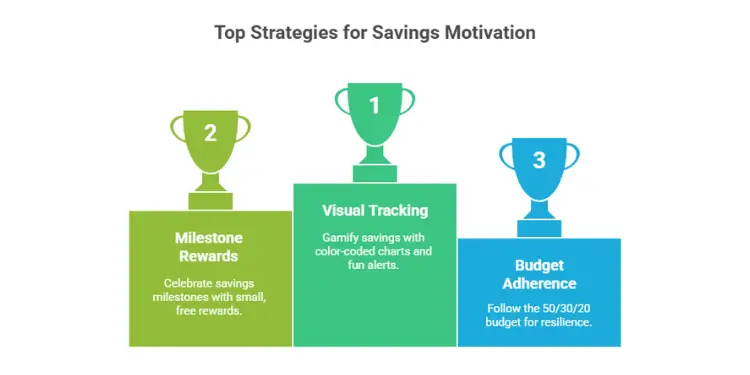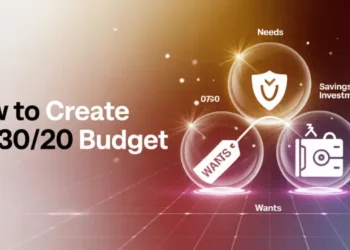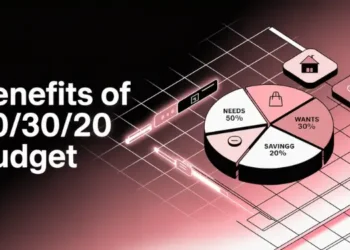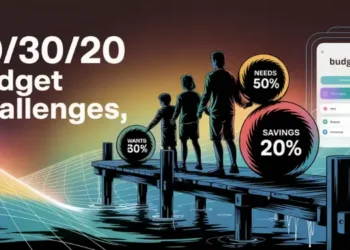50/30/20 budget is my top choice for managing money. It helps us divide each paycheck into needs, wants, and savings. This makes money management easier and less stressful.
Want to know how small changes can make a big difference? Almost 40% of Americans live paycheck to paycheck, says the Consumer Financial Protection Bureau. A local credit‑union partner says, “Budgeting is the anchor that steadies every storm.” I paid off $80k of debt by saving consistently. Check out this budget breakdown for helpful tips.
The 50/30/20 budget allocates 50 % of after-tax income to essential expenses, 30 % to discretionary spending, and 20 % to savings or debt repayment. Key practices include automating split transfers on payday, conducting weekly or weekend audits via banking apps, and negotiating lower rates on fixed costs such as insurance, utilities, and subscriptions.
Discretionary “leaks” are controlled through preset spending caps—such as a weekly dining-out allowance—and surprise income like bonuses or tax refunds is funneled directly into savings. Quarterly reviews of category percentages and visual tracking tools ensure alignment with targets and support adjustments after major life changes.
Key Takeaways:
- Allocates 50 % income to essential expenses.
- Dedicate 30 % income toward discretionary spending.
- Reserve 20 % income for savings and debt.
- Automate paycheck splits for consistent saving.
- Negotiate fixed costs to increase savings.
- Conduct quarterly reviews to maintain balance.
Automate transfers on every payday

Imagine your paycheck going to two places. We’ll keep some for bills and send the rest to your emergency fund. This happens as soon as you get paid.
Retirement research shows that automating contributions boosts participation rates, contribution levels, and overall balances Ref.: Alycia Chin et al. (2024). “Deepening our Understanding of Savings Automation in Retirement and Non-retirement Contexts.” Wharton School, University of Pennsylvania. [!]
Set split rules in employer portal
Go to your payroll site and set aside a part of your paycheck. We’ll save at least 20% for emergencies, debts, or goals. A study shows automating savings builds stronger funds [Fed, 2022].
Our brains relax knowing money goes to savings before we spend it.
Automated saving rules are linked to significantly higher savings balances, according to a CFPB study of mobile savings behaviors Ref.: Consumer Financial Protection Bureau (2022). “Consumer Savings App Strategies and Savings Outcomes.” CFPB. [!]
Schedule weekend audits in mobile app
Check your bank app on Saturday to see where you spent too much. Look for big spends on food or streaming. Then, cut back next week.
We’ll watch your spending closely and fix any issues. Spend just five minutes today to start saving automatically. And remember to check your spending on the weekends.
Slash fixed costs through savvy shopping
There’s hidden savings in our monthly income. Insurance, cable, and gym memberships often cost too much. They take money away from our savings.
We can save by talking to providers and finding discounts. Big savings can happen when we mention other deals. A quick call can free up money for paying off debt or living costs (Census Maine, 2023).

Negotiate rates on insurance and subscriptions
We’ll tackle big expenses with a call plan. First, find providers and ask for discounts. Here’s a simple guide:
- Insurance: Ask for policy reviews and discounts for multiple lines.
- Streaming: Remove extra channels or ask for seasonal discounts.
- Gym: Look for free fees and friend referrals.
| Potential Bill | Negotiation Tip |
|---|---|
| Car Insurance | Bundle auto and home for a loyalty discount. |
| Internet Service | Ask for promotional rates and mention competitor pricing. |
| Mobile Plan | Drop unused data add-ons or switch to a lower tier. |
Take five minutes to list your top bills. Pick one to call about next Monday. That call could add to your savings.
Read More:
Plug discretionary leaks with spending caps
Imagine a lobster boat with a leak. Small holes can hurt our savings too. We’ll stop big shopping by setting limits on non-essential spending.
This keeps our money in balance. A budget tool helps track every penny. It keeps us from spending too much.

Many people forget their monthly costs. We’ll control our spending better. This way, we avoid buying things we don’t need.
Limiting spending on fun, clothes, and snacks is key. We’ll set a budget for these things. This stops us from spending too much on small pleasures.
Check out this guide for tips on budgeting. It helps keep your money safe for the future.
Impulse spending remains a key threat, as individuals who don’t track every dollar risk blowing discretionary budgets Ref.: Experian (2022). “Why Is Budgeting Important?” Ask Experian. [!]
Cap dining out using weekly allowance
We’ll give ourselves a weekly budget for eating out. We’ll take out cash at the start of each week. This makes us think twice before spending.
Make a list for grocery shopping. Be careful with weekend snacks. Try this for a week and see how it helps your budget.
Supercharge savings via occasional windfalls
Imagine a strong wind blowing us across Casco Bay. This feeling is like getting holiday bonuses or gifts. Instead of spending it all, we can put it in our emergency fund or pay off debt.

Think of it as “money for tomorrow” from the start. This way, we avoid buying things on impulse. It helps us stick to our 50/30/20 budget plan. Adjusting the split helps us catch up if we’re behind on savings.
- Deposit a portion directly into a high-yield account
- Use a budget app to earmark any surprise income
- Set up text alerts for swift transfers
Direct tax refunds straight to savings
Tax season brings a chance to save more. Many people don’t have an emergency fund, as research from Bankrate shows. Putting tax refunds into savings helps with unexpected costs or rent increases.
| Windfall Source | Potential Use |
|---|---|
| Tax Refund | Emergency Fund Boost |
| Company Bonus | Extra Debt Payment |
| Cash Gift | Future Rent or Mortgage |
Set up the deposit instructions now so the next windfall heads straight to savings before it tempts you.
Review category percentages quarterly for efficiency
Tides shift around Maine’s rocky coastline, and our finances can drift the same way. Child-care fees may rise, or new job roles might spark pay changes. Bundles once labeled Wishes can balloon, so we watch for creeping expenses.
Frequent reviews keep us moored to the 50/30/20 approach. Data from local credit-unions shows families who recast budgets every quarter stay balanced. Let’s keep “Needs” at 50, “Wishes” at 30, and “Savings” at 20.
A quick monthly check helps confirm your after-tax paycheck matches these targets. It only takes ten minutes. One parent found rising grocery costs pushed “Needs” above 50%. Shifting meal plans trimmed expenses to stay on course.
For more budgeting insights, read this simple blueprint that outlines easy efficiency hacks.
Adjust ratios after life changes
Life events call for rethinking your ratios. Weekend coaching workshops at local banks show that if “Wants” exceed 30, a few cost cuts can restore balance. If child care shifts or a second job emerges, your “Savings” could jump.
A short quarterly review keeps you on target. Check the full family guide at this resource for more ways to stay nimble.
Gamify progress using visual tracking tools
We can track our savings like a lobster boat charts its catch. A color-coded chart or an app with fun alerts makes saving exciting. A Federal Reserve survey found 40% of Americans can’t cover a $400 emergency.
This shows why tracking our savings is important. Every small step under the 50/30/20 budget feels like a win. It builds real resilience.

Celebrate milestones with small free rewards
We might have a game night at home or watch a beach sunrise to celebrate. Simple rewards keep us motivated and prevent burnout. These moments make saving fun without spending too much.
The 50/30/20 rule divides after-tax income into exactly 50% for needs, 30% for wants, and 20% for savings or debt repayment Ref.: Robert (2025). “The 50/30/20 Rule Explained: Budgeting Made Simple.” The Inspiring Journal. [!]
If you want more ideas, check this guide for ways to celebrate each victory. We’ll grow these habits together, like a Maine harbor welcomes calmer tides. Looking at your tracker might inspire the next big step.












